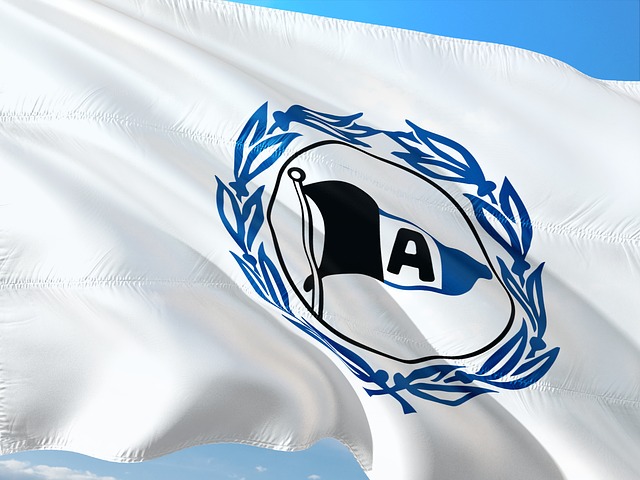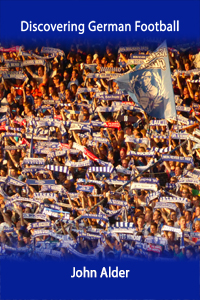DSC Armenia Bielefeld – the club and the town
Bielefeld is on the eastern edge of North Rhine Westphalia, beside an ancient forest called the Teutoburger Wald. Hannover is about 70 kilometres to the north-east and Dortmund is the same distance to the south-west. The city has 327,000 inhabitants is the home of the international baking products company Dr Oetker and the manufacturing giant Schüco.

In the early 1980s, I was fortunate to spend two years in Bielefeld. And I lived just around the corner from the Alm – Armenia’s ground. This is where I first experienced German football.
Bielefeld had just been promoted back into the Bundesliga and was about to embark on a five-year stint in the top tier. The previous season the club had won the 2 Bundesliga in record-breaking style. They scored 120 goals, achieved a 28 match unbeaten run and won 30 of the 38 games. There was a confident a buzz about the club. Attendance and expectations were high.
Since those exciting days, fans have endured a lot for their club. At one point Bielefeld fell right out of the professional leagues. A gradual climb back to the top preceded full-time membership of the “elevator group” – those teams that continually move up and down the divisions.
Despite repeated financial difficulties and the occasional threat of bankruptcy, the club has survived. Long-suffering fans are currently enjoying a period of success. In 2014/15 a run of thrilling victories over bigger clubs took them to the semi-final of the German Cup. Bielefeld were 3. Liga champions the same year and moved up to the 2. Bundesliga. A draw on the last day of the season secured a 15th place finish in 2016/17, which just enough for a further year in the second division. The current season has started well for Bielefeld and the promotion places are still within reach.
Tickets
You can buy them at the fan shop in the Osttribüne of the stadium. There is also an online ticket shop.
Getting to Bielefeld
There are frequent direct trains from Hannover and Dortmund to Bielefeld. The journey will take about an hour from either city.
Getting to the ground
The simplest way to get to the ground from the station is on foot. It will take you about 15 minutes. If you don’t feel like walking, it’s also easy to reach by public transport.
Exactly how you travel depends on where you are sitting or standing in the stadium.
Block 1 – 4 (Südtribüne) and Block M – T (Osttribüne)
Take the tram (Stadtbahn) 4 towards “Universität/Lohmanshof” and get off at “Rudolf-Oetker Halle”.
Block B – J (West-/Nordtribüne)
Take the tram (Stadtbahn) 4 towards “Universität/Lohmanshof” and get off at Graf-von-Stauffenberg-Straße.
Block A1 & A2 (Away end)
Take tram 3 towards Babenhausen Süd and get off at Wittekindstraße.
Inside the ground
The SchücoArena is named after the club’s main sponsor. It has a capacity of 26,515, with 8,000 standing places. Thanks to a phased ten-year modernisation programme it is a comfortable and modern venue with great visibility throughout.
Local rivals
Key information
- Website
- Facebook Twitter
- Email info@arminia-bielefeld.de
- Telephone +49 (0)1806 – 51 53 02
- Online Ticket Shop
- Ground: SchucoArena
- Capacity: 26,515
- Average attendance 17/18: 18,002
- Address: Melanchtonstraße, 33615 Bielefeld
- Colours: White and blue
- Nickname: Die Blauen (the blues)
A few numbers
- Seasons in the Bundesliga: 16
- Position in the all-time Bundesliga table: 21
- Biggest home win: 5:0 against Borussia Mönchenglabdbach (8.5.82) and Darmstadt (21.4.79)
- Stadium capacity: 26.515
- Highest attendance: 26,329(78/79)
- 2 Bundesliga champions: 1999
- 2 Bundesliga Nord champions: 1978 1980
- West German Champions: 1921/22, 1922/23
- Westfalen Champions: 1912, 1921-1927, 1933, 1962, 1990
- West German Cup Winners: 1966
- Westphalian Cup Winners: 1908, 1932
- Westfalen Cup: 1991, 2012
- Bundesliga promotion years: 1970, 1978, 1980, 1996, 1999, 2002, 2004
DSC Armenia Bielefeld – A short history
The early days
At the beginning of the 20th century the nearest thing to sporting clubs in Bielefeld were two social clubs called Teutonia and Terpsichore whose members played a variety bof sports.
In 1904 two Terpsichore members, Alwin Bohlen and Jonny Hennigstein, put forward the idea of starting a football section1904. The club hierarchy turned this down. Their proposal did, however, inspire Emil Schröder to join them in setting up their own club and put an advert in the local paper.
On 14 April 1905 fourteen men met in Restaurant Modershohn, in the cellar of the town hall, and decided to form a club. On 3 May 1905 1. Bielefelder Fußballklub Armenia was founded.
Members paid a monthly fee of one mark and the club colours were blue white and black.
The new team played its first game two weeks later on Kaiser Wilhelm Platz in the town centre against a team from Osnabrück. Armenia players wore orange. We don’t know the result.
Soon new members started to join and in the autumn Arminia made contact with DFB and played its first league games in Bezirksliga Westfalen in the 1906/07 season. Bielefeld played against Osnabrück teams Teutonia, Olympia 1903 and FC 1899 and came third.
By now other clubs had started to form in the town and in 1907 the Bielefeld Sportverband (Sports Union) was founded. In same year FC Siegfried joined Armenia and the club moved to a new ground in Kaiserstraße (August Bebel Straße today).
Unfortunately, the land was taken over by the town after five months and at the same time, the club found itself beset with financial problems. After a new president improved finances stabilised and in 1910 Armenia moved to Pottenau.
First success and a new home
Bielefeld’s first big success came in the 1912/13 season when they were crowned as Westfalen champions and lost the regional semifinal to Düsseldorf SC.
The outbreak of war stopped the progress of the club which was reduced to playing at district level and won the 1916 and 1917 championships. 1919/20 was first real post-war football season. Unfortunately, travel restrictions imposed by the victorious allies meant the championship could only be played in part (Armenia played 17 out of 18 games. FC Osnabrück 99 only managed 8).
That year Armenia merged with Bielefelder Turngemeinde 1848 with the aim of establishing a big sporting club with many sections. One later DSC won the eastern section of Kreisliga Westfalen, but they had signed an ineligible new player (Friemauth). This led to a 3-month ban and they missed the Westfalen final against Preussen Münster
Next year Bielefeld ended on equal points with Kölner BC 01. A deciding game was played in München Gladbach (now Mönchengladbach). Armenia lost 2:1, but the result was reversed because Cologne had played an ineligible player (Scottish defender Gregor Smith) in a league game against Essen. As a result, points were deducted from Cologne and Armenia won the league. This meant they competed for the first time in the German championship, but lost 0:5 to FC Wacker München
In 1922, as in other towns across Germany, the football and gymnastics clubs separated. In 1922/23, as league champions, Bielefeld played in the regional final against TuRU Düsseldorf, coming back from being 3:1 down at halftime to win in extra time, qualifying for the national finals for the second time. The club booked a special train to transport fans to games. The quarter final in Bochum against SC Union Oberschöneweide was abandoned after 2.5 hours at 0:0. The replay was played in in Berlin. Bielefeld lost 1:2 aftyer conceding a goal in added time.
Walter Claus-Oehler was Bielefeld’s first national player. He made is debut on 10 May 23 against Netherlands. The club would then have to wait 75 years for the next nation callup.
After this the glory days on the national stage were over. Armenia won the Wesfalian championships four times but did not progress from West German to the national championships.
Bielefeld was involved in the first live broadcast of a football match which covered a game against Preußen Münster at Münstermannplatz on 1 November 1925.
On 30 January 1926, the club changed its name to Deutscher Sportclub Armenia Bielefeld and also made the move to the Alm which remains home today.
The new ground opened on 1 May 1926, but success continued to elude DSC, which for a time was eclipsed by another local side – VfB 03 Bielefeld. Attendance dropped and finance worries returned. DSC was saved by lucrative friendlies against Hamburger SV and 1. FC Nürnberg. Bielefeld fans had to wait until 1932 before they could celebrate the club’s next sporting success – defeating Osnabrück to win the Westfalia Cup.
There were many reasons for Bielfeld’s lack of success.
One of the greatest was complacency. The 1920s and 1930s saw the dramatic rise of the Arbeitervereine (working class clubs like Schalke, Dortmund), but many Bielefelders did not consider them ‘proper’ football teams or worthy opponents One of these clubs wrote suggesting a friendly. The reply from Bielefeld proposed they learn to play football first. The club was called FC Schalke, who went on to dominate regional and national football throughout the 1930s.
Bielefeld under the Nazis
During the war years players called up for military service, making it impossible to get a team together. Leading members of the club strongly supported the politics of the Nazi regime. Jewish members were expelled and banned from the ground. Fritz Günewald, a former board member had to return an Ehrennadel (badge of honour) He died in the Warsaw ghetto. His badge was returned in 2003.
After the war
The club reformed after the war and joined Landesliga Westfalen, but was relegated to Bezirksliga in 1947, placing Bielefeld in the third tier for the first time. The next season (1947/48) DSC looked set for promotion but were docked 14 points for fielding an ineligible player
The next year the regional Landesliga was expanded to include Armenia, who won the league and got promotion to Oberliga West
Relegation followed at the end of the next season and a further drop in 1954 returned Bielefeld to the third tier.
Performances then gradually improved and by 1962 Bielefeld was back in the second division. The club didn’t qualify for Bundesliga when it was formed in 63 and only just made it into the league below (Regionalliga)
Back to the top
Bielefeld just missed promotion in 1967 and finally made it to the top tier in 1970.
In 1970 Bielefeld was involved in a match-fixing scandal. As a result, two players were banned for life. Although the club was allowed to play 1971/72 in the Bundesliga it was demoted at the end of the season. Left with massive debts, its very existence at risk.
But by the end of 1978 Armenia wasback in the Bundesliga. Demotion the next year was followed by promotion the year after. This was one of Bielefeld’s most successful seasons ever. Key statistics include. 30 wins out of 38 games, 28 game unbeaten streak and 11:0 win over Hannover.
Despite struggling to avoid relegation the club remained in the Bundesliga for the next five years
Gradual decline
But falling attendance compounded ongoing financial problems led eventually to relegation in 1985. The club then went into free fall, dropping out of the professional leagues altogether and continued to face horrendous financial difficulties.
Between 1994 and 2005 Bielefeld enjoyed steady improvement. Veterans Thomas van Helen, Armin Eck and Fritz Walter signed. The club was promoted to Regionalliga West/Südwest, then the 2 Bundesliga and eventually back to the Bundesliga for 1995/96
Ups and downs
Despite signing international star Stefan Kuntz the club finished 14th and was relegated in 1997/98.
The 1998/99 was another promotion season and Bruno Labbadia was the league top scorer with 28 goals
In 1999/00 a run of 10 successive defeats was the low point of a miserable season which ended in yet another relegation. And Bielefeld just avoided a further drop in 2000/01.
Promotion and relegation were to be the pattern for the next decade.
The glory days return
2014/15 was a brilliant season. They reached the semi-final of the cup by beating Hertha BSC, SV Werder Bremen and Borussia Mönchengladbach) and emerged as 3 Liga champions.
2015/16 was stable but it 2016/17 relegation was only narrowly avoided. The battle to secure second division status went right down to last two games – 6:1 win over Eintracht Braunschweig and 1:1 draw against Dresden
The club still has carries debts from the 2000s and being a Bielefeld fan continues to have low as well as high points. But the 2017/18 season was a good one and a times promotion to the Bundesliga appeared to be within grasp.
Famous players
Born in nearby Schloß Holte Ewald Lienen began his professional career with Arminia in 1974. He left the club in 1977 for Borussia Mönchengladbach. His second spell from 1981 to 1983 coincided with the most successful period in the club’s recent history. He had a second term at Borussia before ending his career with MSV Duisburg. Since then he has managed 14 clubs in Germany and abroad and is currently with FC St Pauli.
Uli Stein began his professional career with Bielefeld, making 124 appearances between 1976 and 1980. He also played for Hamburger SV (1980-87 and 1994-95), Eintracht Frankfurt (1987-94) before a second spell with Armenia (1995-97). He also played six times for the national side between 1983 and 1986.
He was known for his tempestuous nature and sometimes his actions had negative consequences. For example, in 1986 he was dropped from the national team after calling Franz Beckenbauer a Suppenkasper (laughing stock). In 1987 he was sacked by Hamburger SV after punching Bayern player Jürgen Wegman after he scored a goal during a super cup final.
Bruno Labbadia played for SV Darmstadt, Hamburger SV, 1 FC Kaiserslautern, Bayern Munich, 1. FC Köln, Werder Bremen, and Karlsruher SC. He also made 98 appearances and scored 50 goals or Arminia Bielefeld between 1998 and 2001. Since 2003 he has managed 6 Bundesliga clubs, most recently Hamburger SV.
Werner Hellwig (1925 – 2008) was a defender.
He began his career during the war with Kriegspielgemeinschaft Bielefeld and joined Armenia in 1944.
He was badly injured and lost arm 1944 but continued to play in the early post-war years
For one year he was given special permission to take throw-ins with one arm
Walter Claus-Oehler (1887-1941) was a left half. He played for Armenia from 1918 to 1935 and was the first Bielefelder to play for Germany. He died in Paris during the war.
Stefan Kuntz was a striker who scored 179 Bundesliga goals. He began his career with Borussia Neunkirchen before signing for VfL Bochum in 1983. Between 1980 and 2005 he played for 9 clubs. He played for Bielefeld from 1996 to 1998, making 65 appearances and scoring 25 goals. With Kaiserslautern he won the cup in 1990 and the league in 1991.
He played for Germany 25 times and scored 6 goals and was a member of the squad which won the 1996 European Championship.
Find out more about German football

This short guide will help you plan your trip and decide which clubs to visit. There is also key information on every club in the top three divisions as well as links to the best books, websites, blogs and podcasts.
